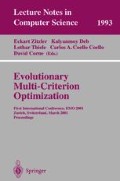Abstract
We present an evolutionary approach to a difficult, multiobjective problem in groundwater quality management: how to pump-and-treat (PAT) contaminated groundwater to remove the most contaminant at the least cost. Although evolutionary multiobjective (EMO) techniques have been applied successfully to monitoring of groundwater quality and to containment of contaminated groundwater, our work is a first attempt to apply EMO to the long-term (ten year) remediation of contaminated water. We apply an improved version of the Niched Pareto GA (NPGA 2) to determine the pumping rates for up to fifteen fixed-location wells. The NPGA2 uses Pareto-rank-based tournament selection and criteria-space niching to find nondominated frontiers. With 15 well locations, the niched Pareto genetic algorithm is demonstrated to outperform both a single objective genetic algorithm (SGA) and enumerated random search (ERS) by generating a better tradeoff curve.
Access this chapter
Tax calculation will be finalised at checkout
Purchases are for personal use only
Preview
Unable to display preview. Download preview PDF.
References
Wagner, B. J., Recent advances in simulation-optimization groundwater management modeling, Rev. Geophys., Supplement, U.S. Natl. Rep. Int. Union Geod. Geophys., 33, 1021–1028, 1995.
Freeze, R. A., and S. M. Gorelick, Convergence of stochastic optimization and decision analysis in the engineering design of aquifer remediation, Ground Water, 37(6), 934–954, 1999.
McKinney, D. C., and M. Lin, Genetic algorithm solutions of groundwater management models, Water Resour. Res., 30(6), 1897–1906, 1994.
Ritzel, B. J., J. W. Eheart, and S. Ranjithan, Using genetic algorithms to solve a multiple objective groundwater pollution containment problem, Water Resour. Res., 30(5), 1589–1603, 1994.
Cieniawski, S. E., J. W. Eheart, and S. Ranjithan, Using genetic algorithms to solve a multiobjective groundwater monitoring problem, Water Resour. Res., 31(2), 399–409, 1995.
Goldberg, D. E., Genetic Algorithms in Search, Optimization, and Machine Learning, Addison-Wesley, Reading, Mass., 1989.
Horn, J., N. Nafpliotis, and D. E. Goldberg, A niched Pareto genetic algorithm for multiobjective optimization, The Proceedings of the First IEEE Conference on Evolutionary Computation (ICEC’ 94), Piscataway, NJ: IEEE Service Center, 82–87, 1994.
Fonseca, C. M., and Fleming, P. J., Genetic algorithms for multiobjective optimization: formulation, discussion, and generalization, Proceedings of the Fifth International Conference on Genetic Algorithms (ICGA 5), San Mateo, CA: Morgan Kaufman, 416–423, 1993.
Srinivas, N., and Deb, K., Multiobjective optimization using nondominated sorting in genetic algorithms, Intl. Journal of Evolutionary Computation, 2, 221–248, 1994.
Oei, C., Goldberg, D. E., and Chang, Tournament Selection, Niching, and the Preservation of Diversity, IlliGAL Technical Report 94002, 1994.
Maxwell, R. M., Understanding the effects of uncertainty and variability on groundwaterdriven health risk assessment, Ph.D. dissertation, Univ. of Calif., Berkeley, 1998.
LaBolle, E. M., G. E. Fogg, and A. F. B. Tompson, Random-walk simulation of transport in heterogeneous porous media: Local mass-conservation problem and implementation methods, Water Resour. Res., 32(3), 583–593, 1996.
Chan Hilton, A. B., and T. B. Culver, Constraint handling for genetic algorithms in optimal remediation design, J. Water Resour. Plan. Manage., 126(3), 128–137, 2000.
Author information
Authors and Affiliations
Editor information
Editors and Affiliations
Rights and permissions
Copyright information
© 2001 Springer-Verlag Berlin Heidelberg
About this paper
Cite this paper
Erickson, M., Mayer, A., Horn, J. (2001). The Niched Pareto Genetic Algorithm 2 Applied to the Design of Groundwater Remediation Systems. In: Zitzler, E., Thiele, L., Deb, K., Coello Coello, C.A., Corne, D. (eds) Evolutionary Multi-Criterion Optimization. EMO 2001. Lecture Notes in Computer Science, vol 1993. Springer, Berlin, Heidelberg. https://doi.org/10.1007/3-540-44719-9_48
Download citation
DOI: https://doi.org/10.1007/3-540-44719-9_48
Published:
Publisher Name: Springer, Berlin, Heidelberg
Print ISBN: 978-3-540-41745-3
Online ISBN: 978-3-540-44719-1
eBook Packages: Springer Book Archive

